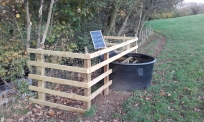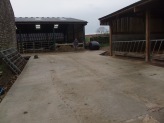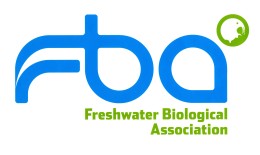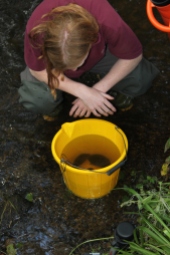Ryan Harvey – River Esk & Coastal Streams Catchment Partnership Officer
Hi there, I’m Ryan the new Partnership Officer for the River Esk & Coastal Streams Catchment – its part of a Catchment Based Approach and my post is jointly hosted by the National Park Authority and the Yorkshire Esk Rivers Trust (YERT) . I started back in August and what a fantastic experience I’ve had so far. My role is very varied and fulfills a broad range of objectives: liaising with landowners and farmers, managing volunteers, working with partner organisations and carrying out surveys. All this effort is in the hope of benefiting the ecology of the Esk and building strong relationships and partnerships to maintain the ecology into the future.
It all started with the electro fishing season. That meant getting to know our e-fishing volunteers and arranging some refresher training for them. This was a great opportunity for me to meet the team ahead of our actual surveys and set the scene for the coming weeks. Once the work started along with volunteers I had the much appreciated help of Victoria Franklin (our Conservation Trainee) and Ami Carrick (our Ryevitalise Education & Engagement Officer). Electro fishing is a hugely important element of our data collection on the Esk. It allows us to gain a better understanding of our fish species diversity and abundance, in particular migratory species such as salmon (Salmo salar), sea trout (Salmo trutta), European eel (Anguilla anguilla) and lamprey (Lampreta planeri).

Our sites are repeated year on year and we now have a record of each species population over the last six years. This along with a whole suite of other data collecting techniques better informs our next steps and future conservation measures.
We are looking for new electro fishing volunteers for the 2020 season, so if this is something that may interest you please don’t hesitate to get in touch with our Volunteers Team. We can offer all the training you might need.
Another aspect of my role has been working alongside our Pearl Mussel Volunteers who have a long standing history in the National Park; some of its volunteers have been working with us for over 10 years. The volunteers’ work is invaluable because it’s through this group (along with contractors) that we get most of the physical works and restorations done on the river. There are usually volunteer tasks every two weeks at locations along the Esk and in surrounding riparian habitats. Tasks can vary from week to week for instance woodrush and tree planting for bank stabilization and habitat creation, riverbank fencing and repair to help water quality, as well as hedgerow and riverside grassland management to enhance biodiversity. We don’t stop for winter; this year so far we’ve tackled left over Himalayan Balsam pulling/bashing tasks on the upper Esk catchment.
Our 26 existing Riverfly Volunteers have been busy as ever in 2019, providing vital spot data on the Esk’s freshwater invertebrates. This data is crucial as many of our invertebrates are indicator species and being very sensitive they act as useful litmus for water quality and pollution. Many invertebrates are key component of freshwater and riparian food webs and many other species feed on them. Rivers need to be clean for them to thrive and in turn every other species will benefit. The data returns from 2019 have all been highly valuable for us and the national Riverfly Partnership, with most sites showing high levels of target group abundance and a few showing the highest levels in the last three years, which is encouraging news – hopefully this trend continues into 2020!

Our Adopt a Stream initiative is also a great source of data for the catchment. Another long standing citizen science project, this has volunteers who “take ownership” of given sections of the Esk, which they monitor on a month to month basis. Volunteers note down the general ecology of the site, the state of the river (flow regimes and water levels), any pollution inputs, any litter and invasive non-native species. This allows us, through the eyes of the volunteer, to recognise any apparent issues along the Esk. So if this is something you might be interested in, if you have a favourite walk or spot along the catchment you care about and like to visit frequently, then please get in touch and help us to continue to monitor the ecological health of the Esk Valley.
In addition we are hoping to start addressing some of the remaining in-river obstacles such as weirs, culverts and fords. This work could help towards the restoration of natural river processes and hydrology of the Esk and also importantly aid the passage of migratory fish species, such as salmon, trout, lamprey and eels. Structures can prevent fish species migrating up river to spawning sites and also prevent successful downstream migration of our salmon smolts which, added to the decline of salmon at sea, has further compounded population declines in the catchment in the last few decades. We found extremely low juvenile salmon numbers from our electro fishing surveys; this suggests that the installation of fish passage and fish easements could be a vital part of the continued conservation efforts along the Esk.

Lastly but most importantly there are our pearl mussels. The catalyst for all this work over the last decade and into the future is our Freshwater pearl mussel (Margaritifera margaritifera) population in the River Esk. We work with land managers as well as our volunteers and contractors to fence river corridors, plant trees/vegetation, stabilise and restore river banks in order to:
- reduce diffuse pollution because mussels require oligotrophic (low nutrient) conditions, and
- tackle erosion and sedimentation leading to suspended solids in the river because juvenile mussels require clean gravels with good oxygen circulation.
A strong salmonid population supports good healthy mussel numbers as the fish are crucial to the mussel’s life cycle – the larval form (glochidia) use the fish as hosts by attaching to the gills until large enough to detach and then self sustainably live within the river gravels. This is why we’re so keen on our river obstacle work because we want fish to spawn all the way up the catchment, creating strong, wide spread populations. Helping the fish helps the mussels and the mussels, being bivalves, help clean the river which in turn provides better conditions for our freshwater invertebrates, which then are fed on the by the fish and the cycle continues….

Everything in the river is connected and helping one species will help another, this is why all our conservation work is so important and why partnership and cooperation between our volunteers, land managers and partners is crucial for the future of the River Esk.


































































